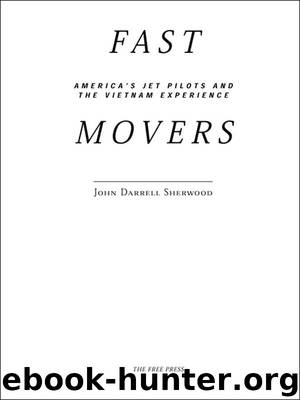FAST MOVERS by JOHN DARRELL SHERWOOD

Author:JOHN DARRELL SHERWOOD
Language: eng
Format: epub
Tags: History
Publisher: THE FREE PRESS
Published: 2000-10-31T00:00:00+00:00
Jim and Sue Latham
Under what circumstances is it appropriate for a wife to visit her husband in a combat area? This is an age-old question that the U.S. military has been struggling with, to a greater or lesser degree, since its founding. During the American Revolution wives lived in Army camps and cooked and did laundry for the troops. When a battle commenced, these women would assist the medical corps in caring for wounded soldiers. But despite the obvious labor benefits of camp-followers, some American military leaders perceived them as an impediment to combat operations. George Washington, for example, complained in his diaries that women put unnecessary strain on his logistics system. Although wives again made appearances in combat areas during the War of 1812 and the Civil War, they virtually disappeared during later overseas wars such as World War I, World War II, and Korea because of the great distances involved and the fact that the military controlled all means of transportation to and from combat areas.
However, the advent of cheap commercial air travel changed matters considerably during the course of the Vietnam War. Army wives generally could not secure visas to travel to the Republic of Vietnam, but Air Force wives had no trouble getting into Thailand, a nominally neutral country where many of the Air Force’s squadrons were based during the war. During the early stages of the war, these wives would come and visit their husbands during their leave periods and stay in Bangkok, just like Navy wives who visited their spouses in the Philippines. By the 1970s, however, some wives began to take up permanent residence in Bangkok, and by 1972 a few of the younger and more adventuresome wives even started living right off base in towns such as Ubon. One of these was Sue Latham.
Born in 1947, Sue Latham, then Sue Beach, grew up on an alfalfa farm outside of Pierceville, Kansas, a prairie town near Garden City. An average student and a cheerleader in high school, Sue left Pierceville in 1965 to attend Kansas State University in Manhattan, Kansas in preparation for a career as an elementary-school teacher. While at KSU she met her future husband, Jim Latham.
Jim, like Sue, was a Kansas native, but he grew up in Shawnee Mission, a suburb of Kansas City, and did not share Sue’s rural background. The son of a pediatrician, Jim went to Kansas State with only one intent: to fly and fight with the United States Air Force. “Basically, I majored in getting out.” 113 At K State, Jim enjoyed drinking beers at Kites, a popular student bar in Manhattan, with fellow Air Force ROTC Cadet Roger Locher. The two officers were commissioned together, standing side by side on graduation day at Kansas State in 1969. Little did they know on that sunny spring day that one of them would pull off the most miraculous evasion of the war and the other, an equally courageous officer, would end up in the Hanoi Hilton after making a heroic attempt to evade his captors.
Download
This site does not store any files on its server. We only index and link to content provided by other sites. Please contact the content providers to delete copyright contents if any and email us, we'll remove relevant links or contents immediately.
| Africa | Americas |
| Arctic & Antarctica | Asia |
| Australia & Oceania | Europe |
| Middle East | Russia |
| United States | World |
| Ancient Civilizations | Military |
| Historical Study & Educational Resources |
1-Bound by Honor(690)
The Saigon Sisters by Patricia D. Norland(485)
Abandoning Vietnam by James H. Willbanks(470)
The March of Folly by Barbara W. Tuchman(458)
We Were Soldiers Once...and Young by Harold G. Moore;Joseph L. Galloway(448)
Into Cambodia by Keith Nolan(437)
A Time for War: The United States and Vietnam, 1941-1975 by Robert D. Schulzinger(435)
Charlie Company's Journey Home by Andrew Wiest(435)
Where the Domino Fell by James S. Olson & Randy Roberts(435)
What We Inherit by Jessica Pearce Rotondi(432)
Rethinking Camelot: Jfk, the Vietnam War, and U.S. Political Culture by Noam Chomsky(425)
The United States, Southeast Asia, and Historical Memory by Pavlick Mark;(421)
Green Beret in Vietnam by Gordon Rottman(415)
12, 20 & 5 by John Parrish(414)
Gunship Pilot by Robert F. Hartley(413)
Carrier: A Guided Tour of an Aircraft Carrier by Tom Clancy(411)
A Piece of My Heart by Keith Walker(409)
They Were Soldiers by Joseph L. Galloway(394)
America At War - Concise Histories Of U.S. Military Conflicts From Lexington To Afghanistan by Terence T. Finn(380)
